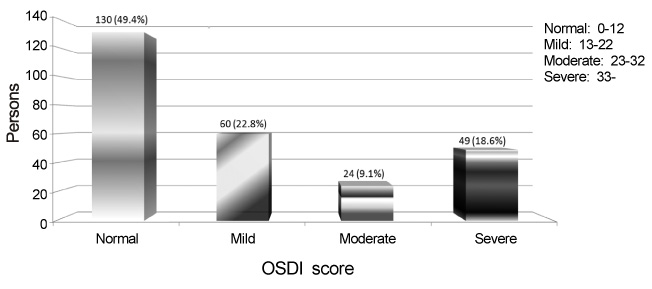J Korean Ophthalmol Soc.
2012 Apr;53(4):505-509.
Prevalence of Dry Eye Disease among University Students
- Affiliations
-
- 1Department of Ophthalmology, Korea University College of Medicine, Seoul, Korea. Crisim@korea.ac.kr
Abstract
- PURPOSE
To determine the prevalence of dry eye disease (DED) and risk factors among young people based on the Ocular Surface Disease Index (OSDI) questionnaire.
METHODS
The authors of the present study distributed the OSDI questionnaire to 263 university students. DED was diagnosed when the OSDI score was greater than 13 points. According to the OSDI score, DED was classified as mild (13-22 points), moderate (23-32 points), or severe (33-100 points). Additionally, the associations between the OSDI score and possible risk factors such as gender, contact lens use and allergic conjunctivitis were studied.
RESULTS
Of 263 students, diagnosed DED was present in 133 (50.6%) and severe cases of DED were observed in 49 (18.6%). A high OSDI score was associated with female sex (p < 0.01), a history of allergic conjunctivitis (p = 0.02), contact lens use (p < 0.01), self-awareness of the dry eye symptoms (p < 0.01) and a history of clinically diagnosed DED (p < 0.01).
CONCLUSIONS
Prevalence of DED, which has been reported to be high in the elderly, was considered high at 50.6% among young people in the present study. Caution or education regarding DED is necessary for people who have a high OSDI score, particularly females, contact lens wearers and people with allergic conjunctivitis.
Keyword
MeSH Terms
Figure
Reference
-
1. Lemp MA. Report of the National Eye Institute/Industry Workshop on Clinical Trials in Dry Eyes. CLAO J. 1995. 21:221–232.2. The definition and classification of dry eye disease: report of the Definition and Classification Subcommittee of the International Dry Eye Workshop (2007). Ocul Surf. 2007. 5:75–92.3. McCarty CA, Bansal AK, Livingston PM, et al. The epidemiology of dry eye in Melbourne, Australia. Ophthalmology. 1998. 105:1114–1119.4. Lin PY, Tsai SY, Cheng CY, et al. Prevalence of dry eye among an elderly Chinese population in Taiwan: the Shihpai Eye Study. Ophthalmology. 2003. 110:1096–1101.5. Schein OD, Muñoz B, Tielsch JM, et al. Prevalence of dry eye among the elderly. Am J Ophthalmol. 1997. 124:723–728.6. Moss SE, Klein R, Klein BE. Prevalence of and risk factors for dry eye syndrome. Arch Ophthalmol. 2000. 118:1264–1268.7. Shimmura S, Shimazaki J, Tsubota K. Results of a population-based questionnaire on the symptoms and lifestyles associated with dry eye. Cornea. 1999. 18:408–411.8. Chia EM, Mitchell P, Rochtchina E, et al. Prevalence and associations of dry eye syndrome in an older population: the Blue Mountains Eye Study. Clin Experiment Ophthalmol. 2003. 31:229–232.9. Lee AJ, Lee J, Saw SM, et al. Prevalence and risk factors associated with dry eye symptoms: a population based study in Indonesia. Br J Ophthalmol. 2002. 86:1347–1351.10. Brewitt H, Sistani F. Dry eye disease: the scale of the problem. Surv Ophthalmol. 2001. 45:Suppl 2. S199–S202.11. The epidemiology of dry eye disease: report of the Epidemiology Subcommittee of the International Dry Eye WorkShop (2007). Ocul Surf. 2007. 5:93–107.12. Nakaishi H, Yamada Y. Abnormal tear dynamics and symptoms of eyestrain in operators of visual display terminals. Occup Environ Med. 1999. 56:6–9.13. Farris RL. The dry eye: its mechanisms and therapy, with evidence that contact lens is a cause. CLAO J. 1986. 12:234–246.14. Schiffman RM, Christianson MD, Jacobsen G, et al. Reliability and validity of the Ocular Surface Disease Index. Arch Ophthalmol. 2000. 118:615–621.15. Miller KL, Walt JG, Mink DR, et al. Minimal clinically important difference for the ocular surface disease index. Arch Ophthalmol. 2010. 128:94–101.16. Mathers WD, Lane JA, Zimmerman MB. Tear film changes associated with normal aging. Cornea. 1996. 15:229–234.17. Begley CG, Chalmers RL, Mitchell GL, et al. Characterization of ocular surface symptoms from optometric practices in North America. Cornea. 2001. 20:610–618.18. Guillon M, Maissa C. Dry eye symptomatology of soft contact lens wearers and nonwearers. Optom Vis Sci. 2005. 82:829–834.19. Cho YA, Won JS, An GJ. The effect on the dryness of eye during VDT work. J Korean Ophthalmol Soc. 1996. 37:1991–1995.20. Ousler GW 3rd, Hagberg KW, Schindelar M, et al. The Ocular Protection Index. Cornea. 2008. 27:509–513.21. Kim JS, Cho KJ, Song JS. Influences of computer works on blink rate and ocular dryness in adolescents. J Korean Ophthalmol Soc. 2007. 48:1466–1472.22. Uchino M, Schaumberg DA, Dogru M, et al. Prevalence of dry eye disease among Japanese visual display terminal users. Ophthalmology. 2008. 115:1982–1988.
- Full Text Links
- Actions
-
Cited
- CITED
-
- Close
- Share
- Similar articles
-
- Prevalence and Risk Factors of Dry Eye Disease after Refractive Surgery
- Recent treatment of dry eye
- Relationship between Middle school Students' Computer using Time and Dry eye
- Factors affecting dry eye syndrome and quality of life among college students in Korea: a cross-sectional study
- Factors Influencing the Cognitive Degree of Dry Eyes in Nursing Students


